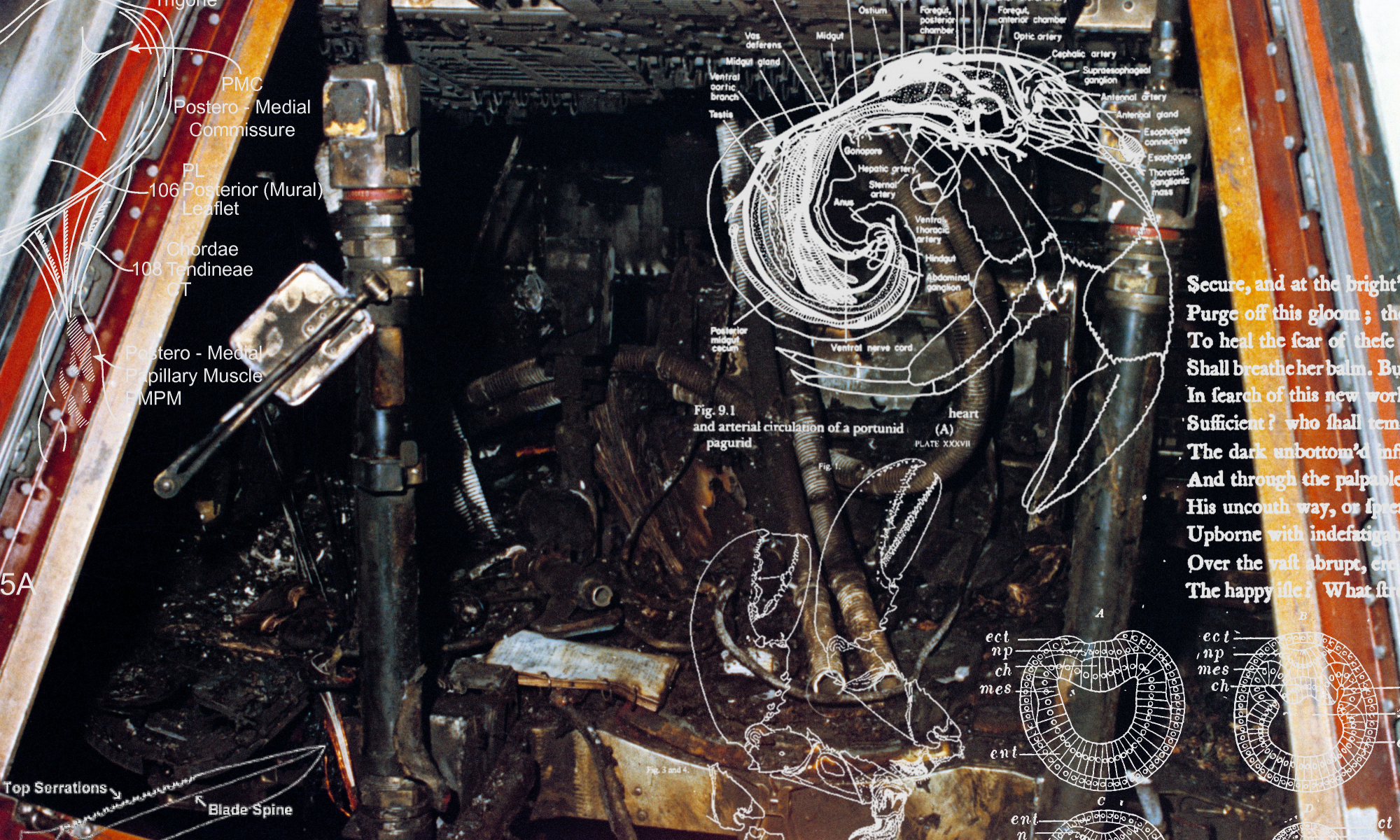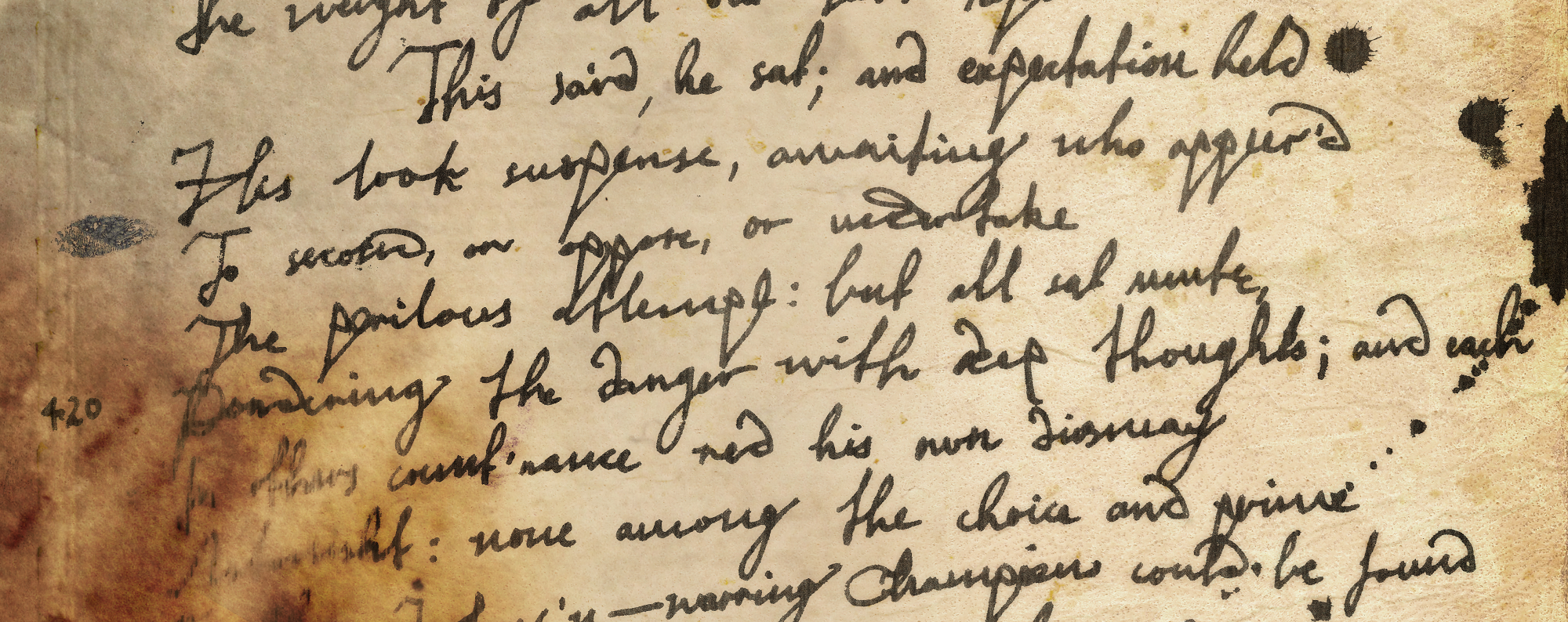by Yves Cross[note]Originally published in the South Pacific Prowler, January 19th, 2018.[/note]
Be careful what you’re saying. Every word you speak is a geological event at the level of palate tectonics. Not a speech-act, but a seismic reverberation.[note]Mark Fisher, “White Magic“, Virtual Criminologies, vol. 6.[/note]
When a new fragment of an original amanuensis manuscript for John Milton’s Paradise Lost was discovered last year in a storage facility in South London, the philology community found itself confronted with an unintelligible anachronism that, despite the confirmed authenticity of the document in question, has yet to find legitimate purchase in Milton scholarship. Two articles published in the November 2017 issue of Modern Philology and the January 2018 issue of MVU’s contentious Plutonics journal, testify to the bewilderment of those few scholars who have taken the recent findings seriously enough to warrant academic appraisal. The papers among which the manuscript was found belong to a Mrs. Deborah Fitzbarrow, originally of Blackdown, Warwickshire, one of the last living remnants of the Fitzbarrow estate.
Like any epic worth the generic denomination, Paradise Lost begins in the middle and speeds up. For those familiar with the first two books of the poem — which tell of Satan and his crew of fallen angels excavating the molten-metal interior of a volcano to construct Pandemonium, and a demonic council at which the Prince of Hell volunteers to cross the dimensionless abyss of Chaos in order to mess with God’s latest creation — the recently discovered fragment (pictured below) raises inescapable questions. Those willing to accept the manuscript’s authenticity are reassessing assumptions regarding the sanity of Milton’s daughters, who were engaged by the poet to transcribe the work during long dictation sessions, or — following certain commentators — the credibility of the anthroposchematic temporal bias hypothesis, which posits nonlinearity as a fundamental attribute of time. As the manuscript quite clearly shows, the letters ‘v’, ‘b’ and ‘p’ in Milton’s idiosyncratic substantive, ‘the vast abrupt’, have been rendered with what appears to be the first recorded usage of the 🅱 emoji.

The 🅱 emoji or ‘Negative Squared Latin Capital Letter B’ was first introduced into Unicode 6.0 in 2010, post-dating Milton’s poem by 343 years. Its proximity to ideograms displaying A, AB and O in the emoji set imply its original significance as a symbol for the B blood type. However, recent détournements of the symbol seem to suggest that the answer to its significance in the poem lies elsewhere.
Dr Asa Noon, a scholar of ‘complexity philology’ and former pupil of the infamous anorganic semiotician, Daniel Charles Barker, has claimed (in the second of the two articles cited above) that the employment of the B emoji in the manuscript can point to only one possible explanation. In Dr Noon’s words: “Milton or his amanuenses were, perhaps unconsciously, channeling something latent in the English language itself (in all human languages for that matter — and even more than that) and whether by intent or simple oversight, this interference of the poet’s native tongue — Oecumenic English — has made its way into the original transcription. The fact that this has been overwritten by the phalanx of later folio scribes, or perhaps ‘corrected’ by the printer, seems entirely consistent with the work of certain historical forces committed to eradicating all traces of geotraumatic linguistic subversion.
“The overwriting of the labiodental fricative /v/ and bilabial plosives /b/ and /p/ with the 🅱 symbol seems to indicate a phonetic collapse that — for those of us interested in the mapping of these fragments via Muvian cultural semiotics onto a certain ‘Time Map’ — invokes a concomitant temporal implosion.” Noon continues, “The Mumumese quasiphonic particle /pb/ is pre-collapsed in the 7th Zone of the Time Map, and naturally pulls in orbiting fricatives, most notably the Horowitzean ‘imploded fricative’ /dt/ consecrated by MVU’s Professor Echidna Stillwell to Zone 2. However, given the absence of /v/ itself among the ten known numogrammatic Zones, the exact character of the implosion remains enigmatic.
“A young Canadian researcher affiliated with the Time-Lapse Sub-Committee here at MVU has recently posited a hexadecimal transvaluation of the time-map known as the ‘hexadecigram’, exploiting the productive potential of a simple modular shift to install new virtual coordinates, bringing in further unexplored Zones that could potentially be the true locus of these unaccounted-for fricatives, including, of course, Milton’s /v/. As it stands, the interference or cata-positioning of the /v/ (via its closest phonic relative /dt/) and /p/ with 🅱 seems to denote a sorcerous interference linking this particularly suggestive epithet from Beëlzebub’s speech with the domain of the syzygetic chronodemon, Oddubb.[note]The convergence of the ‘imploded’ fricative /dt/ with the ‘exploded’ fricative /v/ is also formally tantalising.[/note] This seems odd since, at the very least, a degenerate Lemurian reading of the cosmological imagery deployed in Paradise Lost would align the ‘vast abrupt’ — the formless gulf separating Heaven from Hell, presided over by Chaos — with the Rift fringing the outer zone of Uttunul, that which speaks nothing (with ‘nothing’ read substantively in true Miltonic fashion[note]Milton’s horroi vacui led to his insistence, in the poem, that absence is not lack, emptiness, or inactivity, but rather an utterly superlative presence (overabundant nothing): “darkness visible” [i.63] or the “palpable obscure” [ii.406]. This disturbs the classical metaphysical (and alchemical) model of the relationship between matter and form. Matter is not stability and inactivity opposed to life and activity, rather, stability and inactivity are impositions on energetic base matter. Milton’s frequent nominalisation of adjectives reflects his decision to found his cosmogony on the principle of creatio ex deo. Which then necessarily casts Chaos within God, as God’s dark ground— or ungrund. [For more on this, see: https://vastabrupt.com/2018/01/09/cosmic-dyspepsia-pt3/ -Ed.][/note], and ‘utter’, meanwhile, deriving from the Old English ‘uttera’ denoting ‘outer’ and used by Milton in this sense) or — less degenerately — Uttunul itself, whose syzygetic composition involves Zone 9, thus ‘initiating’ and implexing the 45 demons of Pandemonium — ‘the palace of Satan’ in the poem, created (as noted above) from materials proper to Cthelll.[note]In one of its very first descriptions, Hell is a “prison ordained / In utter darkness” [i.71-2]; “Pandemonium” is presented respectively as “the palace of Satan” [i.Argument]; “the high capital / Of Satan and his peers” [i.756-757], and “Citie and proud seate / Of Lucifer” [x.424-425).[/note] Presuming that the thesis of Muvian cultural traffic infecting the transcription of Paradise Lost has weight, the hexadecigrammatical mapping of consonants might provide a key to resolving this particular enigma.”

Nevertheless, the evident significance of the numbers nine and ten in both the orthodox version of the Time-Map and in Paradise Lost — nine in particular being the immeasurable ‘unit’ of time suffered by the vanquished Satanic crew in Hell before they are roused to action by their Lord, quantified in terrestrial cycles (“Nine times the space that measures day and night”); the number of “folds” and “gates” encircling their prison, and the number of “days” it takes to plunge through Chaos’s realm — has caused Noon to hesitate over these conjectures.[note]Paradise Lost, i.50-2; ii.434-7; ii.643-8, vi.871-4. The significance of nine plumbs deeper, enfolding various lateral references throughout Paradise Lost: a comparison between Satan and Vulcan, the Roman god of fire, seismic upheaval, and metal-working by way of Virgil’s Aeneid; Homer’s depiction of the giant Tityos who, in fetters, “O’erspreads nine acres of infernal ground”; the nine-day descent of Satan and his company through the formless abyss causes Chaos to undergo a “tenfold confusion”, implicitly revealing a ten in the nine, compounded by the conjecture that the time-span of the Fall is a precise ten days, while Satan’s expulsion from Heaven “is not subject to any calculations of time”. (Spectator No. 369, 1965, 3: 391). The ten-in-nine formula presided over by the poem’s chaotic agents makes an ironic lesson of Adam’s discovery, in Books X to XII, that divine judgment is as sure as mathematics.[/note] “In Hell, Satan can still count (nine gates encircle Pandemonium — three of brass, three of iron, three of rock — ‘a row of doors’) but numbers here are nested, intense, shuttling incessantly across a void. Gifted in the tongue of metallurgy, he parses the intensive body of Hell’s earth just as fluently. Everything positive is contained in zero (and zero is immense). … We are pursuing all exploratory avenues at present to see where they will lead. That is all I can say for now.”
To return to the contemporary usage of the 🅱 glyph: since its addition to the emojilexicon in 2010, it has passed through various phases of memetic torsion — from the bearer of encrypted gang semiotics, through parodies of American counter-culture, to an irresistibly absurdist orthographic tic. Oddubbite influence seems to be detectable behind its frequent conflation with the 🅿 emoji — an embodiment of the aforementioned particle /pb/ (Horowitz’s ‘compound plosive’), mapped to Zone 7 by Professor Stillwell, and — not insignificantly — kindling a current that can retrospectively be understood as pushing the cultural memeplex towards an invocation of Katak, a harbinger of base-material vulcanism, continental subsidence, and catastrophic destruction. Perhaps most recently, the 🅱 emoji has been linked to a synthetic mixture of HFCS-42, 4-Methylimidazole, phosphoric acid, sugar, caffeine, and citric acid popularly known as ‘Pepsi’.
“The thesis that Milton’s amanuenses were somehow partaking of that infernal beverage has been considered by the research team here at MVU”, states Noon, “but we’re not entirely sure how they would have procured the drink or even something similar to it in the seventeenth century given the synthetic ingredients it contains. We are currently conducting more research in cooperation with a literary speleographer at Oxford University who has recently proposed a re-reading of the poem through the notion of the alchemical archeus, which is suprisingly consistent with the implications of the anthroposchematic temporal bias hypothesis. He has quite convincingly framed Paradise Lost as a cosmogony founded on metaphysical dyspepsia in which Satan figures as an agent of teleoplexic Pepsi-Chaos incursion, supported by an analysis of historical, political and economic events leading up to the invention of the black, carbonated drink. And of course, the position of Oddubb in the hydrocycle as a deity of ‘steaming swamps‘ (the likeness to the meme of ‘🅱ubbling 🅱epsi’ didn’t escape our notice) is incredibly suggestive.”
Noon’s team has approached PepsiCo for comment. Officially, the corporation refused to make a statement concerning what they referred to in their correspondence as a “nonsensical prank”, however, MVU administration was contacted only last week by someone claiming to be a past employee of the Arnell Group, the now defunct company behind Pepsi’s rebranding efforts in 2009. The email contained a copy of internal correspondence dating from 2007 that espouses a philosophy of “intensive inception” mobilising what are referred to as “plot holes and channels looping the future into the past” for the purpose of “generat[ing] unprecedented innovative leaps in brand contagion and proliferation” — along with a (zygonovically loaded) 27-page design brief from 2008, now well known to the advertising community as the Breathtaking dossier.
Existing publications of the poem are currently being assessed for the need for redaction following the discovery of the 🅱 graphology. The possibility of a revised edition of Paradise Lost hinges on discussions surrounding Milton’s blindness and whether or not the reason for the glyphic re-presentation of the phonemes is to be located in the poet’s own dictation, which presented his amanuensis with a problem she resolved with the new glyph, or whether it was a caprice — or something even more insidious — on the part of the amanuensis herself. When challenged with the claim made recently by one of her institutional detractors that the transcription anomaly in the Fitzbarrow manuscript is an error or simply a coincidence, Noon replied: “Oh it’s very much a coincidence … that’s why we are taking it so seriously.”
The new manuscript fragment will be on display in the MVU public archives from July this year. ![]()


